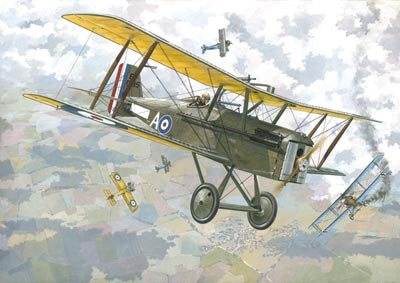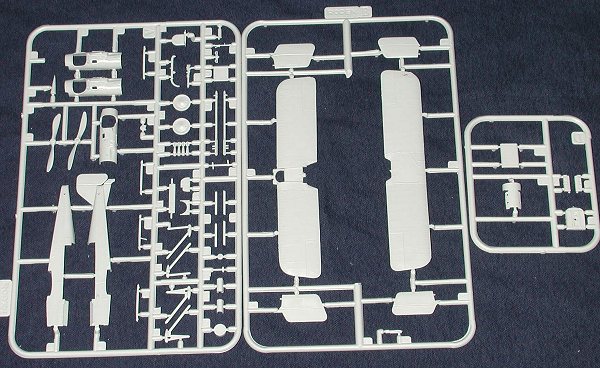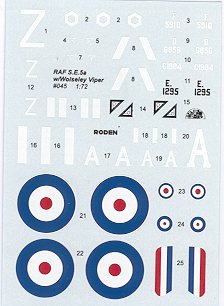|
KIT: |
Roden 1/72 Se.5a
(Wolseley Viper) |
|
KIT # |
045 |
|
PRICE: |
$9.98 MSRP ($8.96 at Squadron) |
|
DECALS: |
Four Aircraft |
|
REVIEWER: |
Scott Van Aken
|
|
NOTES: |
|

The most successful British fighter of WWI was developed in 1917 right after
the severe defeat of the RFC during Bloody April. Its predecessor, the S.E.5,
had very good technical parameters, except for an unreliable 150 hp engine
Hispano Suiza which did not allow for a full demonstration of this aircraft's
potential.
The first flight of the S.E.5a with the more powerful 200 hp Hispano Suiza
engine was conducted in May 1917. One and a half months later the first
mass-production S.E.5a fighters arrived at the Front. Orders for S.E.5a
development were received by several companies: the Royal Aircraft Factory,
and eight sub-contractor firms (Austin, Vickers, Martinsyde, Wolseley and
others). By the end of 1917, 1300 of these fighters were due to be built;
however, only about 800 planes were completed. The Hispano Suiza 200 hp engine
turned out to have many drawbacks and its manufacture was continually affected
by various problems. Attempts to purchase the engine in France failed because
French SPAD fighters also required the Hispano Suiza in large quantities.
Wolseley Motors Ltd. had a license for building the Hispano Suiza in the
United Kingdom. Wolseley's version of this engine with the name Adder was
installed in a small quantity of S.E.5a's, however without success. Wolseley's
engineers modified the design of the 200 hp Hispano Suiza 8A. This engine,
given the name Viper, was expected to solve the problems of the S.E.5a. In
September 1917 an S.E.5a (B4862) with the Viper engine was tested and received
a favorable evaluation - its maximum speed was increased by 7mph, and its rate
of climb improved as well. The RFC specified the Viper as the standard engine
for the S.E.5a (some previously built planes with Hispano Suiza engines going
through major overhaul had their engines changed to the Wolseley Viper). The
'new' S.E.5a differed visually from its predecessor with a radiator of a new
straightened form, with two sets of horizontal shutters. The Foster gun
mounting now fitted directly onto the upper wing. Several flight accidents
that were caused by wing failure led to airframe strengthening.
In the middle of 1918, twenty five RFC squadrons were equipped with the S.E.5a
- 15 on the Western Front, 3 in Macedonia, 2 in the Middle East, 1 in
Mesopotamia, and 4 squadrons in Home Defence. Some of the most successful aces
of the British Empire, including Mick Mannock, James McCudden, Billy Bishop,
and Anthony Beauchamp-Proctor, scored many victories flying this type. Thirty
eight S.E.5a's were delivered to the American Expeditionary Force.
After the end of the Great War the S.E.5a quickly disappeared from the front
line, being replaced by the Sopwith 7F1 Snipe.
The S.E.5a served in the U.S. Army until the mid-1920s. Later, these planes
were used in numerous 'flying circuses' and even took part in Hollywood movies
like 'Hells Angels'.
Historical information courtesy of Roden's website.

This is the first Se.5 kit to be done by
Roden. Judging from their track record, I'd be planning on seeing other versions
of this plane in the near future. As it is a first molding, the parts are all
very well done with only a teeny bit of flash (more like slightly oversized mold
seams) on a few parts. No ejector pin marks in embarrassing areas and no sink
marks. There are all sorts of optional bits and pieces on the sprues but many of
them are not used with this boxing. If you haven't built a Roden WWI kit or seen
one, you'll be quite surprised by the depth of detail that they provide. It
includes a full cockpit with seat, stick, rudder pedals and instrument panel.
This means that a lot of the parts are quite small and can be fragile when
trying to remove them from the sprue gates, so extra care should be taken during
this phase.
 This kit has a set of clear bits
for the windscreens that are not normally a part of other WWI aircraft. They are
really just on a small acetate sheet, but more than accurate enough for this
scale. A bit of extra work is required by the builder to get the parts just
right, but the instructions are extremely well done and point out any
modifications that you'll need to make. Colors are all keyed to Humbrol paints,
but generic terms are given as well. There is no rigging diagram, but the box
art should be helpful in this area. The only real options for this kit are the
choice of prop and windscreen.
This kit has a set of clear bits
for the windscreens that are not normally a part of other WWI aircraft. They are
really just on a small acetate sheet, but more than accurate enough for this
scale. A bit of extra work is required by the builder to get the parts just
right, but the instructions are extremely well done and point out any
modifications that you'll need to make. Colors are all keyed to Humbrol paints,
but generic terms are given as well. There is no rigging diagram, but the box
art should be helpful in this area. The only real options for this kit are the
choice of prop and windscreen.
There are four decal options for this kit, all in matte green over matte linen.
Face it, RFC planes were generally pretty drab. Fortunately, those four schemes
cover some pretty important WWI aces.
- S.E.5A, D6856, No 84 Sqn RAF, Capt. A. Beauchamp-Proctor (54 victories),
1918.
- S.E.5A, F5910/A, No 41 Sqn RAF, Lt. W.G.Claxton (39 victories), 1918.
- S.E.5A, E1295/A, No 74 Sqn RAF, Major Edward "Mick" Mannock, (73
victories), Northen France, July 1918.
- S.E.5A, C1904/Z, No 85 Sqn RAF, flown by Billie Bishop, (72 victories),
Summer 1918, France.
The decals themselves are well printed and quite matte. They also appear to
be very opaque, which is a good thing.
I think you can safely store away your other 1/72 Se.5 kits and concentrate
on this one. If this isn't the version you seek, then just wait a bit for the
others to be released!
Thanks to the fine folks at
 . Visit
them by clicking on the logo.
. Visit
them by clicking on the logo.
You can find this kit and many others at

If you would like your product reviewed fairly and fairly quickly by a
site that has well over 175,000 visitors a month, please contact
me or see other details in the Note to
Contributors.
Back to the Main Page
Back to the Previews Index Page



 This kit has a set of clear bits
for the windscreens that are not normally a part of other WWI aircraft. They are
really just on a small acetate sheet, but more than accurate enough for this
scale. A bit of extra work is required by the builder to get the parts just
right, but the instructions are extremely well done and point out any
modifications that you'll need to make. Colors are all keyed to Humbrol paints,
but generic terms are given as well. There is no rigging diagram, but the box
art should be helpful in this area. The only real options for this kit are the
choice of prop and windscreen.
This kit has a set of clear bits
for the windscreens that are not normally a part of other WWI aircraft. They are
really just on a small acetate sheet, but more than accurate enough for this
scale. A bit of extra work is required by the builder to get the parts just
right, but the instructions are extremely well done and point out any
modifications that you'll need to make. Colors are all keyed to Humbrol paints,
but generic terms are given as well. There is no rigging diagram, but the box
art should be helpful in this area. The only real options for this kit are the
choice of prop and windscreen. . Visit
them by clicking on the logo.
. Visit
them by clicking on the logo.